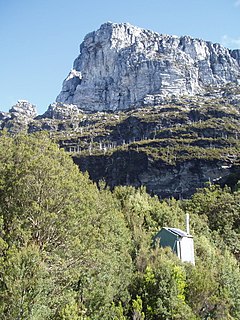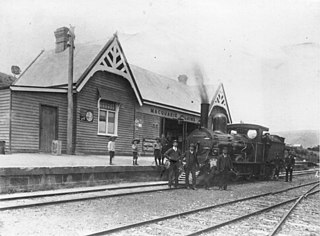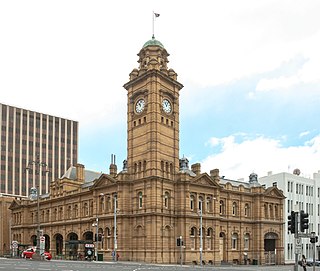
Sullivans Cove is on the River Derwent adjacent to the Hobart CBD in Tasmania.

The Hutchins School is an Anglican, day and boarding school for boys from pre-kindergarten to Year 12 in Hobart, Tasmania. Established in 1846, Hutchins is one of the oldest continually operating schools in Australia. The school's students consistently rank among the highest academic achievers in Tasmania and nationally; it has had 24 Rhodes Scholars. The school is located just under four kilometres from the CBD of Hobart, The Hutchins School offers facilities including classrooms, science and computer laboratories, libraries, a performing arts centre, a recording studio and multiple sporting grounds. International students reside in the school's boarding facility, ‘Burbury House’, which in 2012 underwent a full refit and refurbishment. Hutchins is a founding-member of the International Boys’ Schools Coalition (IBSC), and a member of Independent Schools Tasmania (IST).

Frenchmans Cap is a mountain in the West Coast region of Tasmania, Australia. The mountain is situated in the Franklin-Gordon Wild Rivers National Park.

Bothwell, Tasmania is a small town with a population at the 2016 census of 485. Situated in central Tasmania on the River Clyde in a broad valley, it is notable for hunting and being a lake district. It is part of the municipality of Central Highlands Council and will celebrate the bicentenary of its founding in 2022. Nearby locations include Hollow Tree, Hamilton, Ouse and Kempton.

TheMercury is a daily newspaper, published in Hobart, Tasmania, Australia, by Davies Brothers Pty Ltd (DBL), a subsidiary of News Corp Australia, itself a subsidiary of News Corp. The weekend issues of the paper are called Mercury on Saturday and Sunday Tasmanian. The current editor of TheMercury is Craig Warhurst.

Hamilton is a rural locality in the local government area (LGA) of Central Highlands in the Central LGA region of Tasmania. The locality is about 73 kilometres (45 mi) north-west of the town of Hobart. The 2016 census provides a population of 211 for the state suburb of Hamilton.
Ross Bridge is an historic bridge in the town of Ross in central Tasmania, Australia, completed in July 1836. It crosses the Macquarie River.
Thomas Bather Moore was a pioneer explorer of Western and South West, Tasmania, Australia.

Ross is a village in the Midlands of the state of Tasmania in Australia. On the Macquarie River, Ross is located 78 km south of Launceston and 117 km north of Hobart. The town is listed on the Register of the National Estate and is noted for its historic bridge, original sandstone buildings and convict history.
Noel William Atkins was a former Australian rules footballer who played for various senior clubs in Tasmania between 1945 and 1959 and also represented the state several times in interstate matches. He was inducted into the Tasmanian Football Hall of Fame in 2005.

Franklin Square is an oak-lined public space in Central Hobart, Tasmania, Australia. It is named after Sir John Franklin (1786-1847), the Arctic explorer and former Lieutenant-Governor of Van Diemen's Land ; the centrepiece of the park is a statue of Franklin, with an epitaph by Alfred, Lord Tennyson. It and Hobart Town Hall were built on the site of the former government house of Tasmania. It is on the Tasmanian Heritage Register.

Henry Hunter (1832–1892) was a prominent architect and civil servant in Tasmania and Queensland, Australia. He is best known for his work on churches. During his life was also at various times a state magistrate of Tasmania, a member of the Tasmanian State Board of Education, the Hobart Board of Health, a Commissioner for the New Norfolk Insane Asylum and President of the Queensland Institute of Architects.
Cheshunt House is an Italianate mansion in the Meander Valley, Tasmania, 10 kilometers from Deloraine. It was designed and originally owned by politician, botanist and architect William Archer, started in 1851-52. It was purchased incomplete by the Bowman Brothers from William Archer in 1873, who completed it to his design in 1885. It fell into disrepair during the period of the World Wars and the Great Depression, before a restoration project was undertaken by the family in the 1970s. It is still owned by the Bowman family.
Alan Cameron Walker (1865–1931) was an Australian architect and philanthropist, born in Hobart, Tasmania. The grandson of John Walker, he was educated at Hutchins School and apprenticed to Henry Hunter. He produced many Tasmanian government and other buildings during his career, and was also a keen silversmith, serving as President of the Tasmanian Arts and Crafts Society for 25 years. He was the first President of the Tasmanian Architect's Registration Board.

Gretna is a rural locality in the local government areas (LGA) of Central Highlands and Derwent Valley in the Central and South-east LGA regions of Tasmania. The locality is about 20 kilometres (12 mi) south-east of the town of Hamilton. The 2016 census has a population of 211 for the state suburb of Gretna. It was formerly known as Stony Hut Plains, though the Gretna post office was known as Macquarie Plains for many years. It has a postcode of 7140.

General Post Office is a landmark building located on the corner of Elizabeth Street and Macquarie Street in Hobart, Tasmania, Australia. It stands next to the former Mercury Building and has served as the headquarters of the Tasmanian Postal system since its construction in 1905, though mail processing has now been moved to Glenorchy.
The Tasmanian Heritage Register is the statutory heritage register of the Australian state of Tasmania. It is defined as a list of areas currently identified as having historic cultural heritage importance to Tasmania as a whole. The Register is kept by the Tasmanian Heritage Council within the meaning of the Tasmanian Historic Cultural Heritage Act 1995. It encompasses in addition the Heritage Register of the Tasmanian branch of the National Trust of Australia, which was merged into the Tasmanian Heritage Register. The enforcement of the heritage's requirements is managed by Heritage Tasmania.
St Mary's Cathedral in Hobart, Tasmania, Australia, is the seat of the Roman Catholic Archbishop of Hobart, presently the Most Rev. Julian Porteous.

Isle of the Dead is an island, about 1 hectare in area, adjacent to Port Arthur, Tasmania, Australia. It is historically significant since it retains an Aboriginal coastal shell midden, one of the first recorded sea-level benchmarks, and one of the few preserved Australian convict-period burial grounds. The Isle of the Dead occupies part of the Port Arthur Historic Site, is part of Australian Convict Sites and is listed as a World Heritage Property because it represents convictism in the era of British colonisation.

The Odeon Theatre is a historic live entertainment venue and former cinema in the city of Hobart, Tasmania, Australia.














